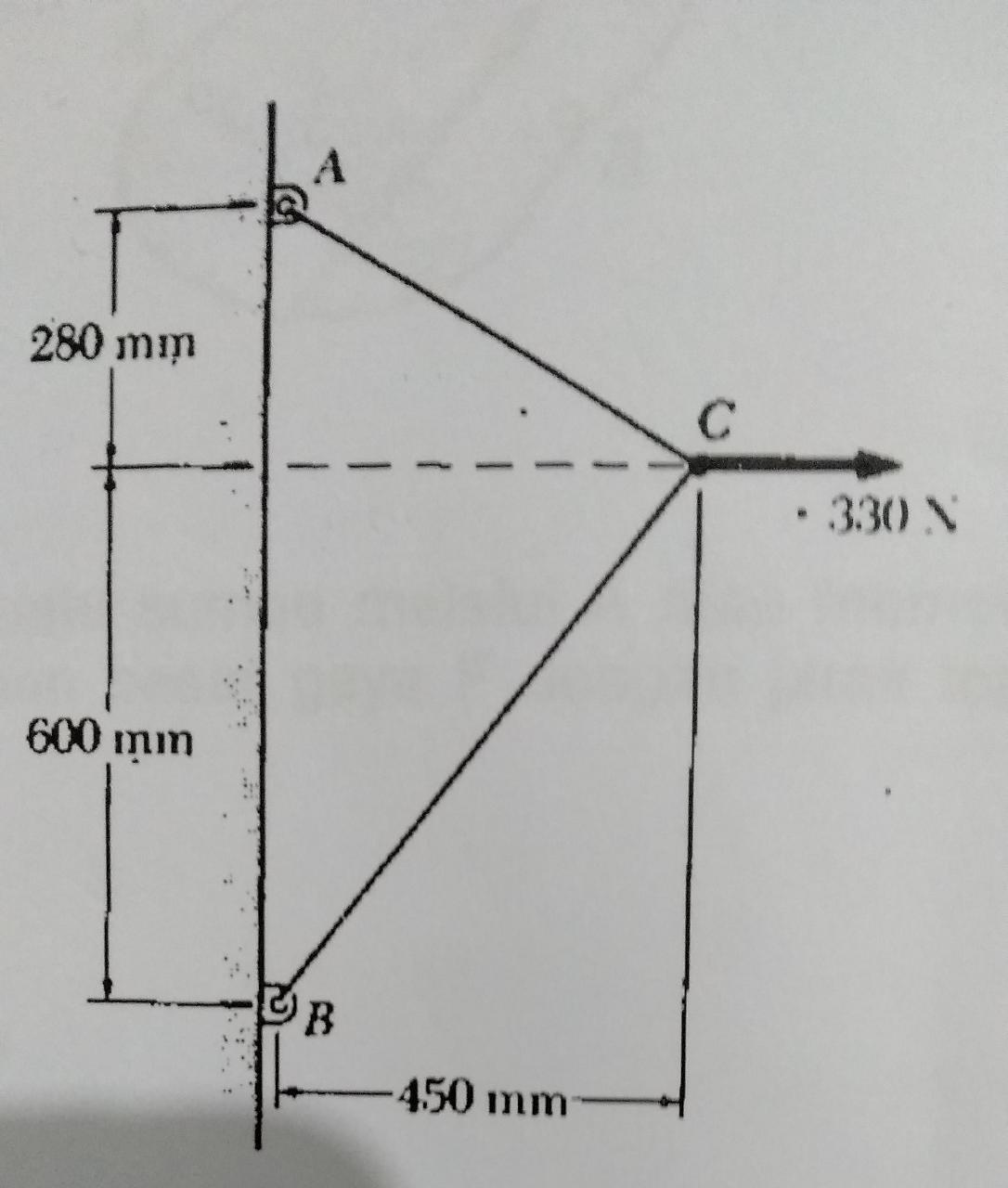
College Physics
11th Edition
ISBN: 9781305952300
Author: Raymond A. Serway, Chris Vuille
Publisher: Cengage Learning
expand_more
expand_more
format_list_bulleted
Concept explainers
Topic Video
Question
determine the x and y direction force components of the following force system

Transcribed Image Text:280 mm
• 330 N
600 mn
450 mm
Expert Solution
This question has been solved!
Explore an expertly crafted, step-by-step solution for a thorough understanding of key concepts.
Step by stepSolved in 3 steps with 5 images

Knowledge Booster
Learn more about
Need a deep-dive on the concept behind this application? Look no further. Learn more about this topic, physics and related others by exploring similar questions and additional content below.Similar questions
- An object in motion will continue to be in motion unless acted upon by an external force to change its state. Choose from the choices below: True Falsearrow_forwardMust answer BOTH parts for upvotearrow_forward12) The diagrams below show different objects of equal masses that are acted on by one or more forces. In the diagrams below, each force vector labeled F has the same magnitude. (i) (iii) 135 (iv) (ii) 2F a. Which of the four objects shown has a net zero force acting on it? (i) (ii) (iii) (iv) b. Which object or objects have the largest magnitude of force? (Select all that apply.) (i)(ii) (iii) (iv) c. Which object or objects move with constant velocity? (Select all that apply.) (ii)(iii) (iv) d. Which object or objects move with changing speed? (Select all that apply.) (1) (ii) (iii) (iv)arrow_forward
- Describe the external force of variable magnitude?arrow_forwardQuestion 4 Which of the following best describes the directions of friction and normal force? Your answer: Friction is always horizontal and normal force is always vertical. Friction is always horizontal and normal force is always perpendicular to the surface. Friction is always parallel to the surface and nomal force is always vertical. Friction is always parallel to the surface and normal force is always perpendicular to the surface. There is no consistent pattem.arrow_forwardplease help with this questionarrow_forward
- Mass on a plane A 100-kg object rests on an inclined plane at an angle of 45° to the floor. Find the components of the force parallel to and perpendicular to the plane.arrow_forward11. Multiple Choice: Two forces have magnitudes of 11 newtons and 5 newtons. The magnitude of their sum could NOT be equal to which of the following values? w) 16 newtons x) 5 newtons y) 9 newtons z) 7 newtonsarrow_forward4. Which of the following vectors represents the resultant force acting on object "X"? a) b) c) d) e) Xarrow_forward
- 4. Determine the magnitude and direction of the resultant force of the concurrent forces as shown below. Solve analytically by using component method. Fe=60N $ Fa=50N X F₂=40N Fr=20Narrow_forwardA flagpole of mass 10.0 kg and length 3.00 m is supported, and on the other by cable , as shown below. A student of mass 80.0 kg hangs on a rope attached 1.00 m from the right end of flagpole a) Draw a free body diagram of the flagpole b) Determine the magnitude of the tension T in the cable [c) A force is exerted on the flagpole from the wall indicate the general direction of this force on your free body diagram State your final answers for part b) using appropriate significant digits.arrow_forwardFNT 13-1 Vectors F EF = 0 F3 on object =? Fr on object =? on object, F2 on object, F3 on object, and F4 on object are all exerted on an object, adding together to form a net force vector EF = 0, as shown to the right. However, only vectors Fi on object, Ēzem-object- on object F2 on object, and EF (which is zero) are It is known that F3 on object object known. is completely vertical, and F4 on object pletely horizontal. is com- On a separate piece of graph paper, use the properties of vector addition to determine the magnitudes of the vertical vector F3 on object, and the horizontal vector F4 on object.arrow_forward
arrow_back_ios
arrow_forward_ios
Recommended textbooks for you
 College PhysicsPhysicsISBN:9781305952300Author:Raymond A. Serway, Chris VuillePublisher:Cengage Learning
College PhysicsPhysicsISBN:9781305952300Author:Raymond A. Serway, Chris VuillePublisher:Cengage Learning University Physics (14th Edition)PhysicsISBN:9780133969290Author:Hugh D. Young, Roger A. FreedmanPublisher:PEARSON
University Physics (14th Edition)PhysicsISBN:9780133969290Author:Hugh D. Young, Roger A. FreedmanPublisher:PEARSON Introduction To Quantum MechanicsPhysicsISBN:9781107189638Author:Griffiths, David J., Schroeter, Darrell F.Publisher:Cambridge University Press
Introduction To Quantum MechanicsPhysicsISBN:9781107189638Author:Griffiths, David J., Schroeter, Darrell F.Publisher:Cambridge University Press Physics for Scientists and EngineersPhysicsISBN:9781337553278Author:Raymond A. Serway, John W. JewettPublisher:Cengage Learning
Physics for Scientists and EngineersPhysicsISBN:9781337553278Author:Raymond A. Serway, John W. JewettPublisher:Cengage Learning Lecture- Tutorials for Introductory AstronomyPhysicsISBN:9780321820464Author:Edward E. Prather, Tim P. Slater, Jeff P. Adams, Gina BrissendenPublisher:Addison-Wesley
Lecture- Tutorials for Introductory AstronomyPhysicsISBN:9780321820464Author:Edward E. Prather, Tim P. Slater, Jeff P. Adams, Gina BrissendenPublisher:Addison-Wesley College Physics: A Strategic Approach (4th Editio...PhysicsISBN:9780134609034Author:Randall D. Knight (Professor Emeritus), Brian Jones, Stuart FieldPublisher:PEARSON
College Physics: A Strategic Approach (4th Editio...PhysicsISBN:9780134609034Author:Randall D. Knight (Professor Emeritus), Brian Jones, Stuart FieldPublisher:PEARSON

College Physics
Physics
ISBN:9781305952300
Author:Raymond A. Serway, Chris Vuille
Publisher:Cengage Learning

University Physics (14th Edition)
Physics
ISBN:9780133969290
Author:Hugh D. Young, Roger A. Freedman
Publisher:PEARSON

Introduction To Quantum Mechanics
Physics
ISBN:9781107189638
Author:Griffiths, David J., Schroeter, Darrell F.
Publisher:Cambridge University Press

Physics for Scientists and Engineers
Physics
ISBN:9781337553278
Author:Raymond A. Serway, John W. Jewett
Publisher:Cengage Learning

Lecture- Tutorials for Introductory Astronomy
Physics
ISBN:9780321820464
Author:Edward E. Prather, Tim P. Slater, Jeff P. Adams, Gina Brissenden
Publisher:Addison-Wesley

College Physics: A Strategic Approach (4th Editio...
Physics
ISBN:9780134609034
Author:Randall D. Knight (Professor Emeritus), Brian Jones, Stuart Field
Publisher:PEARSON